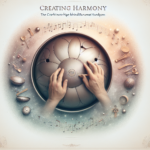The handpan, with its ethereal sounds and captivating resonance, has taken the world of music by storm. In a short period, this relatively new instrument has journeyed from the obscurity of street corners to the grandiosity of concert halls, earning a cherished place in the hearts of musicians and audiences alike. This article delves into the fascinating journey of the handpan, exploring its origins, the nuances of its sound, and its growing popularity across diverse musical landscapes.
Origins of the Handpan
The story of the handpan begins in Bern, Switzerland, in the year 2000. Created by Felix Rohner and Sabina Schärer of PANArt, this musical instrument was a fusion of various elements from traditional instruments like the steelpan, ghatam (an Indian clay pot percussion), and the gamelan ensemble from Indonesia. The resultant creation was named the “Hang,” deriving from the Bernese German word for ‘hand’. The original Hang was composed of two half-shells of steel glued together, with the upper side featuring a central note (the “ding”) and other sound fields arranged in a circle. This design allowed for both harmonic and rhythmic play, making it unique and deeply appealing.
Initially, the Hang was made in limited quantity, given only to those whom the creators felt a genuine connection or affinity. This scarcity and the reverence of the instrument in its early days led to an aura of mystery and exclusivity surrounding it.
The Sound of Serenity
The handpan’s allure lies in its mesmerizing sound. Each strike produces a spectrum of harmonic overtones, creating a multi-dimensional auditory experience. The instrument’s sound can be both meditative and invigorating, largely depending on how it is played. Musicians can produce a wide array of sounds, from soft, melodic tones to percussive beats, fostering a deep connection between the player and the listener.
This versatility has allowed the handpan to transcend genres and find a place in various musical styles, from world music and jazz to ambient and even classical compositions. Its calming and soul-soothing sound has also made it a popular choice for use in yoga, meditation, and therapeutic settings.
From Street Performances to Mainstream Popularity
The handpan initially made its way into the public consciousness through street performances and improvised sessions by passionate players. These intimate displays of musical talent resonated deeply with onlookers and passers-by, leading to a growing interest and demand for the instrument. Street corners became the birthplace of the handpan community, with players coming together to share knowledge, skills, and a love for the instrument.
The internet played a crucial role in the rise of the handpan. Videos of street performances, tutorials, and concerts began to circulate widely on platforms like YouTube and social media. These videos showcased the instrument’s unique sound and the emotive performances of the players, attracting millions of musicians and listeners worldwide. The handpan’s accessibility and expressive range turned it into a viral sensation, leading to a surge in its popularity.
Recognition in the Music Industry
As the handpan’s popularity grew, it began to appear in more formal musical contexts. Musicians started to incorporate the instrument into their compositions and performances, expanding its repertoire and pushing its boundaries. In addition, several contemporary composers and recording artists have taken an interest in the handpan, using it to bring new textures and tonalities to their work.
Many handpan players have also gained recognition in the music industry, performing at festivals, collaborating with renowned artists, and releasing their albums. These musicians have helped elevate the status of the handpan from a street performer’s instrument to a respected and integral part of mainstream music.
Handpan Making: Art Meets Craftsmanship
Handpan crafting is an intricate and delicate process that combines art and science. The steel shells are carefully shaped, tuned, and treated to create the perfect balance of tension and resonance. Each handpan is a unique creation, with no two instruments sounding exactly alike. This individuality adds to the instrument’s charm and allure for both players and collectors.
In recent years, many skilled artisans and companies have emerged, contributing to the evolution and innovation of handpan making. These craftsmen continue to experiment with new materials, designs, and tuning techniques to enhance the instrument’s sound and playability. The growing community of handpan makers has also led to an increase in the availability of the instrument, making it more accessible to aspiring musicians and enthusiasts worldwide.
The Therapeutic Potential of Handpan Music
The handpan’s soothing and meditative sound has captured the attention of not only musicians but also therapists and wellness practitioners. Its harmonics and resonances can create a calming environment conducive to relaxation and healing. As a result, handpan music has started to see applications in therapeutic contexts, such as sound therapy, music therapy, and mindfulness practices.
Some studies have indicated that certain frequency ranges produced by the handpan may help alleviate stress, anxiety, and depression. The deep focus required to play the instrument has also been reported to aid concentration and foster mindfulness. Given these therapeutic potentials, the handpan’s journey continues to expand, offering not just musical joy but also tangible emotional and psychological benefits.
The Handpan Community: A Global Movement
The rise of the handpan has been accompanied by the formation of a vibrant and close-knit global community. Enthusiasts, makers, and players from around the world connect through forums, social media groups, and events to share their passion for the instrument. This community is characterized by a spirit of camaraderie, support, and mutual respect, driving the continuous growth and innovation of the handpan world.
Handpan festivals and gatherings have become essential events where players and fans converge to celebrate the instrument. These events feature performances, workshops, and jam sessions, providing opportunities for learning, collaboration, and forging friendships. The global reach of the handpan community underscores the instrument’s universal appeal and ability to transcend cultural and geographical boundaries.
Conclusion
The handpan’s journey from the quiet streets of Bern to the grand concert stages and wellness spaces is a testament to its unique appeal and powerful resonance. As an instrument, it bridges the old and the new, the rhythmic and the melodic, the personal and the communal. It stands as a symbol of musical evolution, illustrating how innovative instruments can captivate imaginations and transform musical landscapes. As more musicians, therapists, and enthusiasts continue to explore its potential, the handpan’s story is far from over. Its enchanting sound will no doubt reverberate through future generations, continuing to inspire, uplift, and connect people around the world.
FAQs
1. What is a handpan?
A handpan is a musical instrument made of two concave steel shells glued together, with various sound fields on the upper shell. It produces a range of harmonic overtones and can be played both rhythmically and melodically.
2. How is the handpan different from a steelpan?
While both instruments are made of steel, the handpan is played with the hands rather than mallets and produces a unique, resonant sound with rich harmonic overtones. The steelpan, originating from Trinidad and Tobago, is a more established instrument played with sticks.
3. Can anyone learn to play the handpan?
Yes, the handpan is relatively easy to start playing, and its intuitive design makes it accessible to beginners. However, mastering the instrument requires practice and dedication.
4. Why are handpans so expensive?
The creation of a handpan involves a highly skilled and labor-intensive process. Each instrument is handmade and individually tuned, which contributes to its cost. Additionally, the demand for handpans often exceeds the supply, further impacting the price.
5. Where can I buy a handpan?
Handpans can be purchased directly from handpan makers, through specialized instrument shops, or online marketplaces. It’s essential to do thorough research and ensure the instrument is from a reputable maker to guarantee quality and authenticity.





